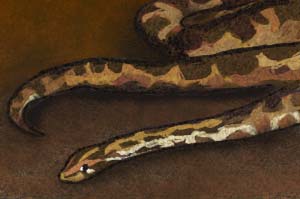|
|
|
|
|
|
|
|
|
|
Python molurus

If you would like to contribute to this Python molurus information page, please send materials to web site editor
| A.K.A. |
Indian Python; Asiatic Rock Python; Black-tailed Python; Burmese Python
|
| SUBSPECIES |
Python molurus molurus - Sometimes called Indian Python; Light Phase Python molurus bivittatus - Sometimes called Indian Python; Burmese Python; Dark Phase
|
| DESCRIPTION COLORATION |
Coloration = browns
with yellow, cream, off-white, and dark brown to black markings.
|
| SIZE |
Max = 30 feet
|
| HOME |
Python molurus
molurus - India; Sri Lanka; Burma
|
| LIFE SPAN |
Up to 40 years
|
| HABITAT |
Forests near water and rocky areas.
|
| LIFESTYLE |
Solitary. Mostly nocturnal; partly arboreal and aquatic. These animals are often seen submerged in water. They have been known to stay submerged for 30 minutes. During the day, these snakes may bask in the sun or remain in a burrow.
|
| PREDATORS |
Small pythons: Royal
Cobra (Ophiophagus hannah)
|
| FOOD |
Small mammals, large mammals including deer, pigs, monkeys, and leopards.
|
|
HUNTING TECHNIQUES
|
Python molurus usually hunts at night. It uses scent and the Jacobson's organ to track it's prey. It will "zero in" on the prey by watching the prey animal's movement and sensing it's body heat. After catching the prey animal, the snake will use it's coils to suffocate and crush the prey until death.
|
| BREEDING |
These snakes are easily bred in captivity. Breeding normally occurs in November, December, or January. Clutches consist of 20 -100 eggs dependent upon the age and health of the female. Females will brood their clutch. They will twitch their muscles in order to increase heat for their eggs. Females may take water but they very rarely eat while they brood their eggs. Young will hatch in approx. 60 - 80 days.
|
|
IN CAPTIVITY
|
These snakes easily
adapt to proper captive conditions. They can become remarkably tame.
However, this species is still not recommended for novice herpetologists
due to the extreme care requirements of their large size.
|
| SPECIAL CONCERNS |
Python molurus
molurus: India has placed this species on it's protected species
list. It is also listed in the First Annex to the Washington Convention
(CITES).
|
For more information see these other Web Sites: